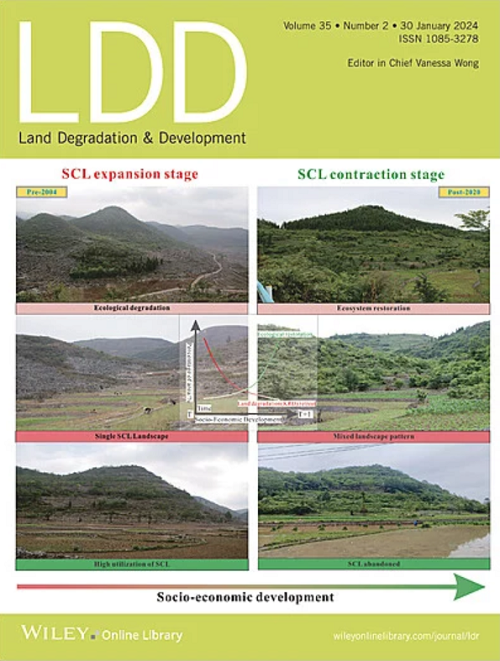A New Approach for Controlling Rill Erosion in Two Typical Erodible Soils in Southern China
IF 3.6
2区 农林科学
Q2 ENVIRONMENTAL SCIENCES
引用次数: 0
Abstract
Most soil erosion on slopes originates from rill erosion, and rapidly and effectively controlling rill erosion is key to the prevention and control of soil and water loss on slopes. We used a novel approach to control rill soil erosion for Quaternary red clay (QRC) and granitic red soil (GRS) in southern China using an ecologically friendly material (W-OH) and verified the effectiveness of the approach using field-simulated scouring experiments with different W-OH concentrations (0%, 0.5%, 1%, and 2%). The results indicated that most of the hydraulic and hydrodynamic indices of runoffs for the two soils differed between sprayed and unsprayed W-OH rills but differed less between the sprayed rills (0.5%–2%), indicating a similar draining effect of W-OH on runoff in the rills. The concentration of W-OH did not significantly affect runoff intensity or its yield but significantly affected sediment concentration and yield, with rates of decrease of 65.0%–99.8% and 43.4%–99.7% for QRC and GRS, respectively, indicating a good effect of W-OH in preventing and controlling rill soil erosion. Pedotransfer functions were built for the two soils under W-OH spraying based on the main hydraulic and hydrodynamic factors affecting rill erosion, which could explain the variabilities of 68.7%–73.8% and 55.0%–55.7% for QRC and GRS, respectively. This study provides a novel and effective approach for controlling erosion in erosion rills in southern China and a basis for predicting the erosion of slopes sprayed with W-OH.中国南方两种典型可蚀性土壤细沟侵蚀治理新途径
坡面土壤侵蚀主要来源于细沟侵蚀,快速有效地控制细沟侵蚀是防治坡面水土流失的关键。采用生态友好材料(W-OH)控制中国南方第四纪红粘土(QRC)和花岗岩红壤(GRS)细沟土壤侵蚀的新方法,并通过不同W-OH浓度(0%、0.5%、1%和2%)的现场模拟冲刷试验验证了该方法的有效性。结果表明:喷施与未喷施的水工水动力指标差异较大,喷施水工水动力指标差异较小(0.5% ~ 2%),表明水工水对水沟径流的排水作用相似。W-OH浓度对径流强度和径流量影响不显著,但对底泥浓度和径流量影响显著,QRC和GRS的降幅分别为65.0% ~ 99.8%和43.4% ~ 99.7%,表明W-OH在防治细沟侵蚀方面具有较好的效果。基于影响细沟侵蚀的主要水力和水动力因子,构建了W-OH喷施下两种土壤的土壤传递函数,可以解释QRC和GRS的变异率分别为68.7% ~ 73.8%和55.0% ~ 55.7%。该研究为华南侵蚀细沟的侵蚀控制提供了一种新的有效方法,并为水oh喷淋坡面侵蚀预测提供了依据。
本文章由计算机程序翻译,如有差异,请以英文原文为准。
求助全文
约1分钟内获得全文
求助全文
来源期刊

Land Degradation & Development
农林科学-环境科学
CiteScore
7.70
自引率
8.50%
发文量
379
审稿时长
5.5 months
期刊介绍:
Land Degradation & Development is an international journal which seeks to promote rational study of the recognition, monitoring, control and rehabilitation of degradation in terrestrial environments. The journal focuses on:
- what land degradation is;
- what causes land degradation;
- the impacts of land degradation
- the scale of land degradation;
- the history, current status or future trends of land degradation;
- avoidance, mitigation and control of land degradation;
- remedial actions to rehabilitate or restore degraded land;
- sustainable land management.
 求助内容:
求助内容: 应助结果提醒方式:
应助结果提醒方式:


